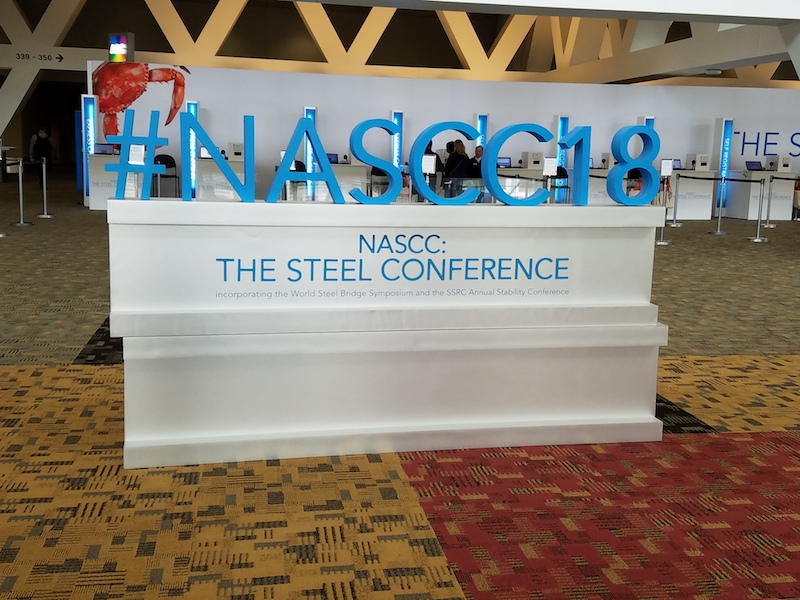Over the past 90 days, the price of steel that Dallas-based DFW Grating buys from domestic mills to fabricate bar and plate grating has nearly doubled. C. Scott Netherton, DFW Grating’s Vice President of Business Development, added that steel distributors are scaling back their inventories unless they are sure they have a buyer.
“We’re not happy with the current situation,” said Netherton, meaning the uncertainty surrounding tariffs imposed on steel and aluminum imports that have rattled the U.S. market, where prices on some products had been rising since late last year.
“What makes this more difficult is that there’s so much momentum as far as manufacturing is concerned, and no one wants to upset that,” said Edward Youdell, President and CEO of the Fabricators & Manufacturers Association (FMA), which represents 1,500 companies.
Youdell and Netherton were manning booths at last week’s Steel Conference in Baltimore, sponsored by the American Institute of Steel Construction (AISC) and attended by more than 5,000 people. Like many attendees, they were trying to sort out the ramifications and consequences of the recent 25% tariffs on steel imports and 10% tariffs on aluminum imports imposed by the Trump Administration on March 23. “Anyone who says they’ve got this figured out is BSing you,” said Youdell.
He fears, though, that small fabricators will struggle to compete in this new competitive environment. “What our members would have preferred is no tariffs, let us have access to cheaper parts, and we could compete globally.”
Underutilized domestic mills could get a boost
Imports accounted for an estimated 27% of the 139 million tons of steel consumed in the U.S. in 2017. A year-long investigation by the U.S. Department of Commerce found sufficient evidence of unfair trade practices by foreign suppliers—notably China—to warrant tariffs to protect the American steel industry under the pretext of national security.
However, it didn’t take long for the administration to exempt several countries—including the European Union, Australia, South Korea, Mexico, Canada, Brazil, and Argentina—that by some estimates account for more than three fifths of all imports coming into the United States. Steel and aluminum suppliers are now scrambling to get specific products excluded from the tariffs.
There have been 1,200 applications for waivers from steel tariffs and 125 requests for exemptions from aluminum tariffs, numbers the Commerce Department confirmed to the Washington Post last Friday. “A tsunami is coming,” Kevin Dempsey, general counsel at the American Iron and Steel Institute, told the Post. “I anticipate there will be several thousand exclusion requests filed.”
Just how much protection the U.S. industry needs from imports, though, is a matter of debate. The top five U.S. steel producers—Nucor, U.S. Steel, Steel Dynamics, AK Steel, and Commercial Metals—all reported positive earnings in 2017 (although some were coming off of years when they lost money). Steel Dynamics alone reported record net income, $813 million, a 113% increase over earnings in fiscal 2016. (SDI did not return BD+C’s request for comment.)
It goes without saying, though, that tariffs could be a boon to underutilized American mills. AISC contends that U.S. steel manufacturers would have excess production capacity even in the unlikely event that they had to replace 100% of imports. (For example, domestic mills, with 10 million tons of structural steel capacity, produced 6.3 million tons last year, with another 1.7 million tons imported.)
“With domestic prices rising even before the tariffs went into effect, it’s been a challenge to buy, and it’s forced fabricators to align closer with suppliers and mills,” said Adam Zakeski, Vice President of Sales-decks and joists for Canam Group, an Allentown, Pa.-based producer and fabricator.
The impact of price hikes debated
Zakeski, Youdell, and Netherton expect prices to stabilize by the third quarter of this year. “Domestic mills can only push prices up so far,” said Zakeski, whose company is buying conservatively at the moment. But he’s skeptical of any rationalizations that “trivialize” the impact of price inflation on the industry’s competitiveness.

Steel and aluminum tariffs were a hot topic of discussion at last week's Steel Conference. Image: BD+C
In a recent webinar, Brian Raff and Tabitha Stine, AISC’s Director of Government Relations and Vice President, respectively, stated that the structural steel package on a $100 million project accounts for about $12 million, of which 30% is for materials from the mill or distributor. So, a worst-case 25% increase in materials costs would equal around $900,000, or less than 1% of the total project cost.
Raff and Stine were quick to note that a 25% tariff doesn’t typically translate to a 25% price increase. And, they said, until recently mill prices had been relatively stable over the past several years, hovering, with some ups and downs, at around $800 per ton.
While it remained uncertain last week exactly which products would ultimately fall under the tariffs, AISC is pushing hard to have fabricated structural steel imports included. “What we’ve been trying to show is that the tariff on mill steel only is subject to circumvention” by countries that could route their steel to companies in other countries that are exempted from the tariff, explained David Zalesne, President of Owens Steel Company in Columbia, S.C.
Zalesne thinks the tariffs are likely to have less impact, positive or negative, than Trump or his critics believe they will. But what happens next is anybody’s guess. The U.S. has indicated that it might end country exemptions in early May. That could lead to a country-by-country quota system as a prelude to new trade negotiations, suggested Frank Swain with the law firm Faegre Baker Daniels, which represents AISC’s interests in Washington.
He and Zalesne also echoed AISC’s insistence that the U.S. should include a “Buy American” provision as part of any infrastructure spending legislation.
“Right now, it’s a poker game,” observed Youdell.
Related Stories
Construction Costs | Apr 16, 2024
How the new prevailing wage calculation will impact construction labor costs
Looking ahead to 2024 and beyond, two pivotal changes in federal construction labor dynamics are likely to exacerbate increasing construction labor costs, according to Gordian's Samuel Giffin.
Affordable Housing | Apr 1, 2024
Biden Administration considers ways to influence local housing regulations
The Biden Administration is considering how to spur more affordable housing construction with strategies to influence reform of local housing regulations.
Affordable Housing | Apr 1, 2024
Chicago voters nix ‘mansion tax’ to fund efforts to reduce homelessness
Chicago voters in March rejected a proposed “mansion tax” that would have funded efforts to reduce homelessness in the city.
Legislation | Mar 21, 2024
Bill would mandate solar panels on public buildings in New York City
A recently introduced bill in the New York City Council would mandate solar panel installations on the roofs of all city-owned buildings. The legislation would require 100 MW of solar photovoltaic systems be installed on public buildings by the end of 2025.
Adaptive Reuse | Mar 15, 2024
San Francisco voters approve tax break for office-to-residential conversions
San Francisco voters recently approved a ballot measure to offer tax breaks to developers who convert commercial buildings to residential use. The tax break applies to conversions of up to 5 million sf of commercial space through 2030.
Affordable Housing | Mar 11, 2024
Los Angeles’s streamlined approval policies leading to boom in affordable housing plans
Since December 2022, Los Angeles’s planning department has received plans for more than 13,770 affordable units. The number of units put in the approval pipeline in roughly one year is just below the total number of affordable units approved in Los Angeles in 2020, 2021, and 2022 combined.
Green | Mar 5, 2024
New York City’s Green Economy Action Plan aims for building decarbonization
New York City’s recently revealed Green Economy Action Plan includes the goals of the decarbonization of buildings and developing a renewable energy system. The ambitious plan includes enabling low-carbon alternatives in the transportation sector and boosting green industries, aiming to create more than 12,000 green economy apprenticeships by 2040.
Affordable Housing | Feb 26, 2024
Biden-Harris Administration announces historic homelessness assistance funding
The Biden-Harris Administration allocation of $3.16 billion in homelessness assistance funding will be administered by the U.S. Department of Housing and Urban Development through the Continuum of Care Program.
Sustainability | Feb 26, 2024
GBBN's Inflation Reduction Act Calculator goes live
GBBN has publicly released its IRA Calculator, a tool that helps you understand funding opportunities in the IRA for sustainable design.
MFPRO+ News | Feb 15, 2024
Nine states pledge to transition to heat pumps for residential HVAC and water heating
Nine states have signed a joint agreement to accelerate the transition to residential building electrification by significantly expanding heat pump sales to meet heating, cooling, and water heating demand. The Memorandum of Understanding was signed by directors of environmental agencies from California, Colorado, Maine, Maryland, Massachusetts, New Jersey, New York, Oregon, and Rhode Island.

















